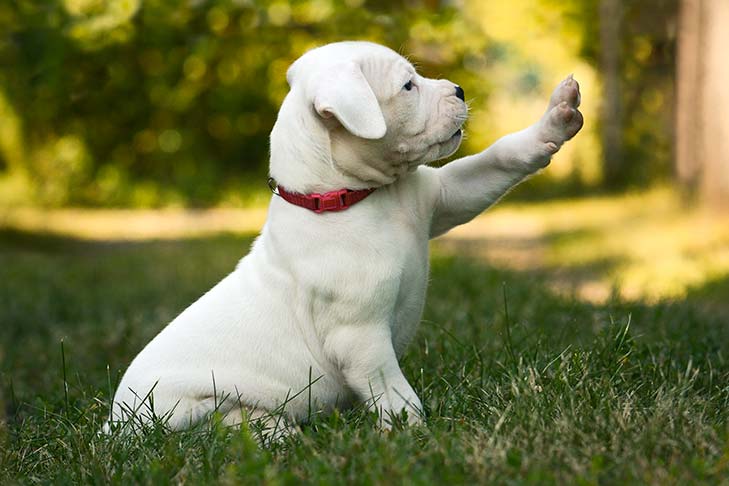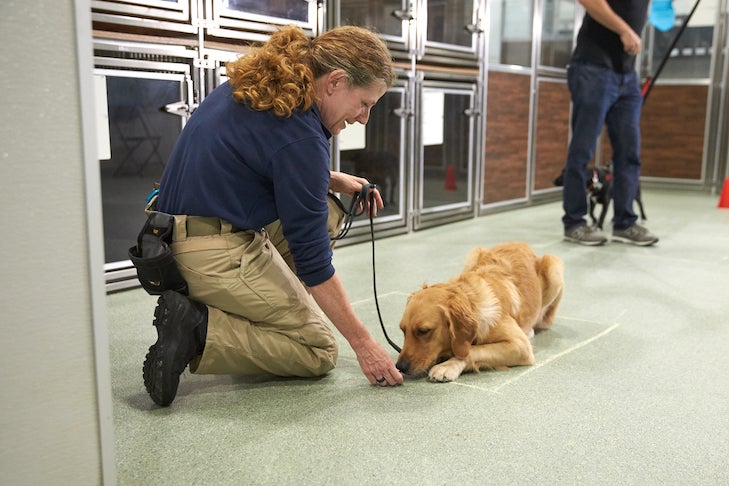Treats play a vital role in the lives of happy and healthy dogs. We’re highlighting an “AKC Treat of the Month” all year long in partnership with Whitebridge Pet Brands. March is all about puppies, including National Puppy Day on March 23. Train your puppy with a range of wholesome treats from Dogswell®.
In the early weeks of bringing home a new puppy, many owners are overwhelmed. There are supplies to shop for, appointments to make, and lots of training to be done. Setting up the right behaviors and expectations during puppyhood is essential, and it starts with puppy obedience training classes.
There are many factors that go into choosing the right obedience training classes for you and your puppy. Certainly, distance is a consideration; however, convenience shouldn’t be the only factor that influences your decision. Other things like training methods, appropriate classes for your needs, compatibility of the instructor’s personality with yours, and certifications of the instructor should also play a role.
Puppy Training: Home or Away?
There are benefits to home training and group class training. Some trainers will come to your home and provide private one-on-one training. Some owners opt to train their own dogs.
Home training may allow you and your dog to focus more on each other. Group class training helps your dog learn to focus, even when there are distractions from other dogs.
One benefit of home training is that it is private — you and your trainer can focus on things you particularly want your dog to learn, while at group classes you may spend time on things you don’t personally find important. In some cases, you may not have any choice but to train at home; remote or rural areas may not have a local training school where you can take group classes.
Choosing an Obedience Training Instructor
Most training schools are happy to allow you to attend and observe a class or two to be sure the style of instruction fits with your beliefs (leave you pup at home for this.) Most dogs learn best through positive reinforcement training; rewarding the dog for making the right choice and withholding rewards, or ignoring the dog for making an incorrect choice.
When observing a class, take note of the dogs; do they look happy? Relaxed? Excited to work? Is the instructor encouraging dogs and owners? Does the class seem to be run in a safe and effective manner? If you don’t feel comfortable at a particular training school, your dog won’t either, and you’ll be setting your dog up to fail. Keep looking for a school where you feel comfortable; both you and your dog will succeed best in this environment.
Trainer vs. Behaviorist
There are some important differences to note between trainers and behaviorists. Behaviorists can also be trainers and/or veterinarians, but not always. Trainers are equipped to handle symptoms, but not necessarily the underlying causes of the symptoms.
Training other behaviors and getting a dog used to being alone, for example, can help reduce separation anxiety. The root cause, however, would likely need to be determined by a behaviorist, who could then refer you to a trainer if he or she was not able to help with the training issues.
Some trainers have certifications from training schools or organizations. It’s always prudent to check the certifications of your trainer, or check references if your trainer is not certified.
AKC Canine Good Citizen (CGC) evaluators are another class of dog-training professionals. AKC CGC Evaluators may or may not be trainers or behaviorists, but are certified by the AKC to evaluate dogs in the Canine Good Citizen test. Training other behaviors and getting a dog used to being alone, for example, can help reduce separation anxiety. The root cause, however, would likely need to be determined by a behaviorist, who could then refer you to a trainer if he or she was not able to help with the training issues.

Types of Obedience Training Classes
There are many types of classes available at different training schools. The schools’ trainers should be able to help you determine which class best meets the needs of you and your dog.
Most schools have a series of puppy classes, starting for puppies as young as eight weeks, and training can progress through AKC STAR Puppy, AKC Canine Good Citizen certification, and advanced obedience classes.
Puppies and owners who complete at least six weeks of class and meet various other basic training and care-taking requirements earn the AKC STAR Puppy certification. The CGC certification is a bit more rigorous and shows that your dog has obedience training and is under control around other people and dogs.
Many schools also offer dog sports classes that you can advance to after basic obedience training, including agility, AKC Rally, tricks, and Flyball.
Obedience Training Equipment
Any training school should tell you what equipment and supplies you should have before you attend the first class.
Most schools want you to arrive with your dog on a flat buckle or snap collar and a regular four-to-six-foot snap-on leash.
But if you have a big, strong dog, and he is hard to control on a flat collar, then body harnesses can be a great option.
Puppy Handling and Socialization
A good training class will do more than just teach you how to train your dog. These days, there is a lot more information available about dog behavior, socialization, and dog body language, and an effective trainer will discuss these topics in class along with the training topics at hand.
Subjects like the importance of socialization of puppies up to 16 weeks old, and reading your dog’s body language, are important topics that are now always discussed in training classes.
Another often overlooked discussion point involves handling and grooming. If your instructor offers good advice and you follow her recommendations, your veterinarian and groomer will thank you.
Practice handling and grooming your pup from the time he is very young, and your vet and groomer will have no trouble examining, treating, bathing, or clipping him. However, if the only time your dog sees nail clippers or a brush is at the vet’s or groomer’s, he will likely come to associate it with scary or unpleasant things.
If you start at home, where your dog is comfortable, you can make the vet and grooming experiences a lot more pleasant for everyone. And as a bonus, many groomers charge less for easy-to-handle dogs, because they can be groomed without the assistance of a second groomer.

Recognize Common Dog Training Problems
Behaviors like jumping on you as a gesture of affection, nipping at your hands as an invitation to play, and sniffing you in inappropriate places are all perfectly acceptable behaviors for dogs to do to other dogs.
However, in the human world, these behaviors are not OK. Remember your dog was born knowing only how to be a dog. If you want him to live successfully in the human world, you must first teach him what is acceptable. This is easiest done with a puppy, but older dogs can learn, too.
Be consistent
If jumping on you is not OK when you’re wearing nice work slacks, then the same rules must be enforced when you’re wearing old clothes to work in the yard.
Don’t forget rewards
When your dog bites at your hands, he wants attention. He wasn’t born programmed to know that you want him to sit and ask nicely for attention, so you have to teach him. Instead of scolding him, ask him to sit. When he complies, reward him with a food treat, lavish praise and petting on him, or offer a game of fetch or tug. Training treats are great for teaching obedience to puppies through positive reward training.
Remember, a quiet dog is easy to ignore, but that’s the time when you should be praising him. If your dog gets your attention only when he jumps on you or bites at you, what is he going to continue to do?
Obedience is for all dogs
Obedience exercises are important for all dogs, especially high-energy breeds that need mental stimulation as well as physical exercise. Simple behaviors like sit, down, stay, come, and leave it are essential for a well-behaved pet. You can challenge your dog even more by teaching him more advanced behaviors like “go to place,” formal heeling, roll over, etc. The old adage — a tired dog is a good dog — is not incorrect. However, a mentally and physically tired dog is even better.
Where to Find a Dog Obedience Trainer
There are many resources for seeking dog trainers, including AKC Training Clubs and AKC Canine Good Citizen Evaluators. Another great resource? Friends and neighbors who own well-behaved dogs. Next time you’re out for a walk and you notice a model canine walking nicely with its owner, stop and ask where the dog was trained. There may be some little-known training facility just down the street from you!
Celebrate the March “AKC Treat of the Month” with 30% off Dogswell® Jerky Soft Strips. Use promo code 30SOFT during checkout on Amazon. Offer valid March 1 through March 31. One bag per order eligible for discount.

